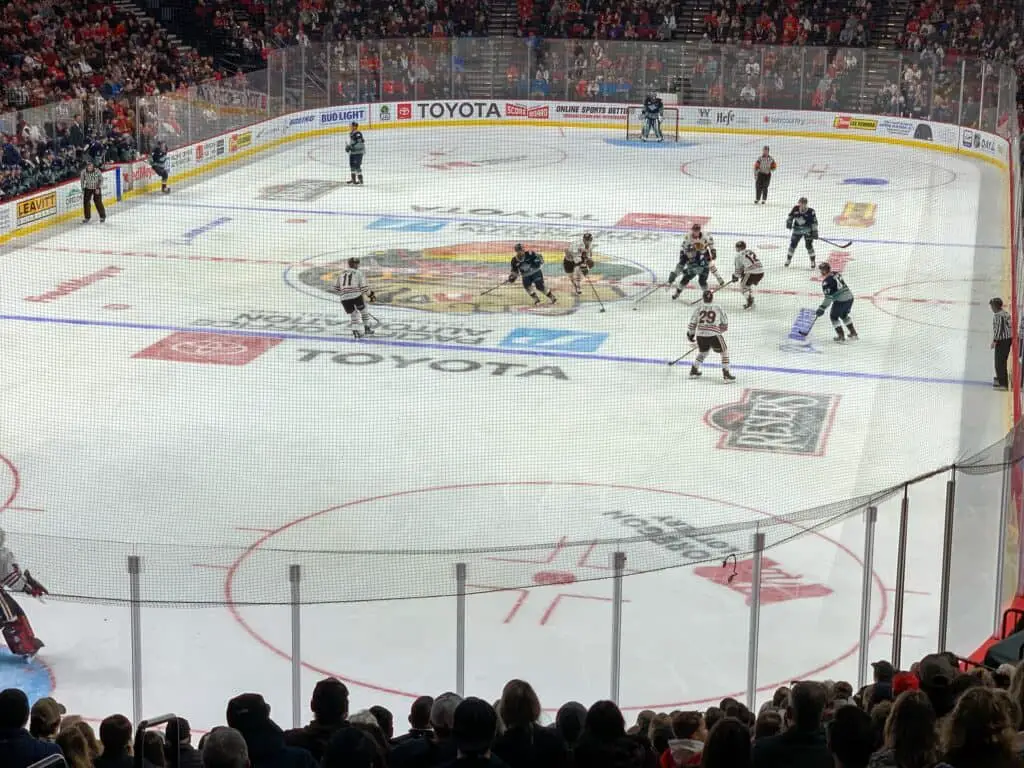For high-level International Ice Hockey Federation (IIHF) rivalries, the suggested measurements of the arena are 60m long and 25–30m wide. For IIHF World Championship competitions, the authority measurements are 60m long and 30m wide. The edges of the arena are adjusted in the circular segment of a circle with a span of 7.0m to 8.5m.
The arena is separated by the red place line, has two blue lines, nine go head-to-head circles, the objectives, and the wrinkles.

Ice surface markings—zones
The region where the objective net is found in the safeguarding zone for the group protecting that net. The center of the arena, between two blue lines, is the nonpartisan zone. The region where the restricting net is found is the assaulting zone or hostile zone.
The 30cm wide focus red line isolates the length of the arena similarly. The two 5cm wide icing lines are checked 4m from the level and center segments of the end sheets at the two closures of the arena.
The blue lines are 22.86m from the level and center segments of the end sheets at the two closures of the arena and are 30cm wide. For outdoor arenas, all lines are 5cm wide.
Ice surface markings— go head to head circles
There are nine head-to-head spots on the ice. These are the lone spots at which an on‑ice official can drop the puck to start the game.
All go head-to-head spots are red except the one at focus ice which is blue. This is the middle go head to head circle and is 30m in distance across.
Four head-to-head spots 60cm in breadth are set apart in the nonpartisan zone. Four go head to head spots 60cm in width and red circles 5cm wide with a sweep of 4.5m from the focal point of the go head to head spot are set apart on the ice in both end zones and on the two sides of every objective.

Arena sheets
The arena is encircled by sheets made out of segments of wood or plastic and painted white. The sheets are 107cm high from the ice surface.
Ice surface markings—wrinkles
There are three wrinkles on the ice: one for every goaltender before either objective net and one at the sheets by the scorekeeper’s seat for on‑ice
authorities.
The objective wrinkle used to exist as an unadulterated half circle with a six-foot span. The NHL plays with a wrinkle that holds the six-foot span yet includes a one-foot line from the objective line that broadens the wrinkle further. The objective wrinkle is the part where a goalie is permitted to work unrestricted. Contact with the goalie while he is in his wrinkle is precluded.

Defensive glass
Straightforward plexiglass, 12m‑15mm thick, is appended to the highest point of the sheets. The glass is 2.4m high behind the objectives and expands at least 4m from the icing line towards the blue line. The glass is 1.8m high at the edges besides before the players’ seats.
There is no defensive glass before the players’ seats. There is defensive glass behind and at the edges of the players’ seats and penalty boxes.
Seats and Penalty Boxes
Two seats on one side of the arena house the players in each group that are right now not in play. These seats broaden the width of the impartial zone and stop at one or the other side of the middle line. The sheets before the seats are deliberately kept without glass before them to permit players to change over the top or through the ways to keep the speed fast. Changes on the fly as a rule have players going onto the hockey arena over the loads up while players leaving the ice pass through the entryways.
On the opposite side of the hockey arena, three more modest seats are utilized for two purposes. The middle seat is the place where the scorekeeper’s table is found. Little seats on one or the other side of this table are the penalty boxes. One for each group, these are utilized to house a player that has submitted an infraction sufficiently genuine to warrant a penalty. These three seats have the standard glass before them as staff and players don’t have to escape these rapidly.